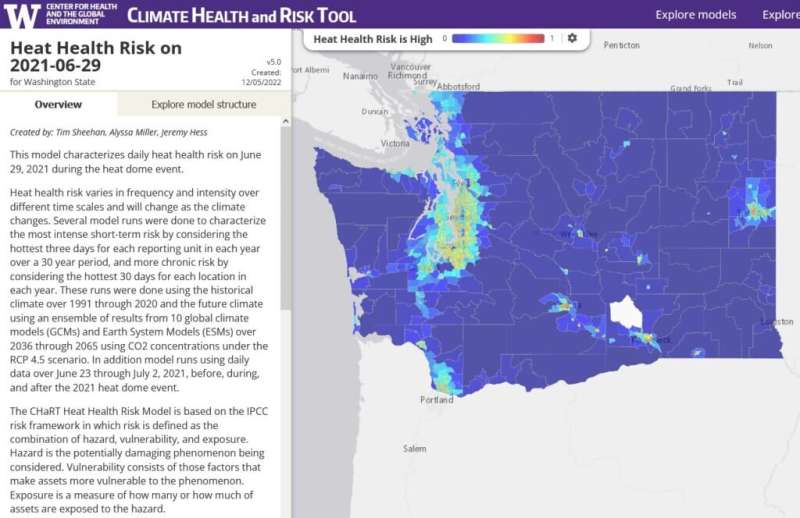This article has been reviewed according to Science X's editorial process and policies. Editors have highlighted the following attributes while ensuring the content's credibility:
fact-checked
trusted source
proofread
New report, tool suggest how Washington can better protect against extreme heat

In June 2021, the "heat dome" that struck the Pacific Northwest sent temperatures in Seattle to an unprecedented 107° Fahrenheit and set 128 all-time high temperature records across the state. The event was partly due to climate change. As the climate continues to warm, these hotter stretches are projected to hit the region with increasing frequency.
Two years after that event—the deadliest weather-related disaster in state history—a collaborative effort led by two University of Washington teams, the Climate Impacts Group and the Center for Health and the Global Environment, or CHanGE, has drawn up recommendations for how people and groups across the state could prevent future heat-related illness and save lives.
"There's a lot we can do, right now, to save lives in Washington," said Jason Vogel, interim director of the UW Climate Impacts Group. "This report is a call to action—it outlines the things that we know work. Extreme heat is a complicated governance challenge that requires coordination across levels of government, including many state agencies without a health mandate, and across the private and public sectors."
"The report highlights the wealth of knowledge we already have about effective strategies," said Dr. Jeremy Hess, director of CHanGE, who treated patients during the June 2021 event and helped develop a related risk-mapping tool. "We need to commit additional resources and build on early investments to protect the most vulnerable."
The new report, led by the UW Climate Impacts Group and released June 20 in English and Spanish, points to solutions. There is no single fix, it argues—the best approach is a broad mix of strategies that address both short-term emergency response and long-term risk reduction.
The report builds on a recent academic paper co-authored by Vogel that compared Washington's heat dome experience against other regions that typically deal with heat. It found that many of the most common strategies, such as cooling centers, don't work on their own. Some people might not recognize their risk, and others might lack transportation to cooling centers. Laws to protect outdoor workers, such as those recently passed in Washington, don't work without enforcement.
The new report suggests a more comprehensive statewide strategy that could reduce illness and death during future heat events. Some of these general suggestions include:
- Providing air conditioners to low-income households, protecting tenants' rights to install air conditioning window units, and revising building codes to require cooling in new construction
- Establishing volunteer networks to check on older or ill neighbors, those who live alone, and other high-risk residents
- Providing transportation to cooling centers
- Developing a portfolio of strategies, because redundancy is crucial
- Increasing enforcement of laws protecting outdoor workers, especially in the earliest and most dangerous days of extreme heat
- Locating toilets and shade structures close to outdoor workers, to encourage breaks
- In urban areas, increasing green roofs, tree cover and structures that provide shade
A full list of strategies is available in the report, which was prepared with partners including Gonzaga University in Spokane, the Office of the Washington State Climatologist, the Washington State Department of Health and UW EarthLab.
CHanGE led development of a related, more specific heat and health tool that can help focus the report's recommendations by tailoring them to a community's specific risks. The Climate Health and Risk Tool (CHaRT) is interactive, which allows local decision-makers to better understand how climate, environmental, social and economic factors contribute to heat risk in their communities. Users can view the short- and long-term risk of dangerously high heat in their community and explore the various demographic, socioeconomic, geographic and medical factors that contribute to that risk.
The tool also provides guidance on how to account for a community's specific needs, both in the short and long term. This information includes summaries of each intervention's effectiveness, as well as expected costs and implementation timelines.
A community with many young children, for example, might consider opening splash parks and sending extra lifeguards to popular swimming spots when temperatures rise. Meanwhile, an urban community with little shade may opt to plant more trees with an eye toward long-term heat mitigation. Splash pads can be implemented quickly and have a local impact, while increasing tree canopy will take decades and can affect entire neighborhoods.
"There are two timeframes we're trying to support action on," said Hess, who is a professor of emergency medicine, of environmental and occupational health sciences and of global health at the UW's School of Public Health. "One is a pretty short time frame, where you get a heat warning, it's going to be hot seven to 10 days from now. What can you and your agencies do to prepare to support the community? How do you support the parts of the community that are most at risk?
"Then there's the longer-term, multi-year time frame. That's a completely different set of challenges. This tool allows for that planning on multiple time scales."
Provided by University of Washington





















